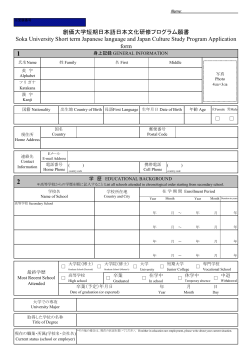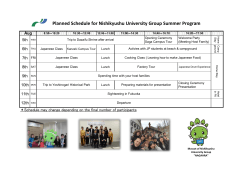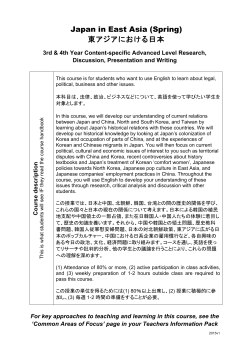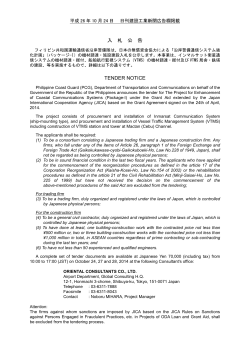
Slow and Steady Technology Integration
License purchased for distribution from Teachers College Record. Lessons Learned from a Chalkboard: Slow and Steady Technology Integration by Bradley Ermeling — April 13, 2015 This commentary compares Japanese and US approaches for integrating technology in K-12 classroom environments. While many American schools are consumed by a haphazard race to adopt the latest gadgets and new innovations, often these devices function as little more than expensive and colorful accessories with minimal influence on existing instructional methods. In other cases, devices sit unused, collect dust, and soon become obsolete, costing thousands of dollars in upgrades. Despite Japan’s much slower pace of technology adoption, one might argue that Japanese educators are well ahead of the US in effective technology integration. Using the chalkboard and bansho (board-writing) as an example, this article describes how Japan’s slow and steady integration approach enables educators to deliberately study and build knowledge about which technologies best facilitate particular learning opportunities. The US should take note and consider a more purposeful integration strategy that emphasizes efficacy over hasty implementation. Last winter, while observing and recording classroom lessons for a research project in Japan, I was surprised to hear a sound I had not heard for many years—the sound of chalk. Over a three-week period of observations in Saitama prefecture, I captured 17 classroom videos from various subject areas across 1st to 12th grade. Every classroom I visited was equipped with a large green chalkboard. There were few computers, few projectors or smartboards, and no other visible forms of 21st century technology in most of the classrooms. Japanese colleagues and researchers confirmed this was representative of the average K-12 classroom in Japan. In January 2015, the Tokyo Broadcasting System reported approximately 75% of Japanese classrooms still use chalkboards as the primary medium for presentation of lesson content (Sankyuu, 2015). My first reaction was one of astonishment. How could Japan, a society known for its creation of gadgets and highly specialized technological devices, be so far behind in their use of 21st century technology? www.tcrecord.org Page 1 of 6 As I continued to record lessons, I began to note the masterful way Japanese teachers utilized this “primitive” instructional medium. I also noted how teachers and students alike maintained the chalkboard with consistent and diligent care. Each class assigned one student to serve as the kokuban kakari (person in charge of the chalkboard) who ensured it was clean and ready for use prior to the opening bell for each period. Teachers treated each centimeter of this freshly cleaned board as valuable real estate. They wrote in straight lines with clear and precise characters and paused to erase stray marks or re-write illegible content. Math and science teachers used meter sticks as a guide to draw perfectly symmetrical diagrams and tables. Language arts and social studies teachers used a variety of chalk colors, each with a consistent meaning and precise purpose related to grammatical terms, literary themes, or systems of government. They used magnetic timers on the board to pace activities and posted magnetic labels of student names to assign workspace for whole-class demonstrations. Most importantly, teachers carefully preserved a lesson storyline as they progressed across the board. They added elements in a strategic sequence that helped bring coherence to the lesson, and rarely erased content unless they reached a major instructional transition. CREATING LEARNING OPPORTUNITIES THROUGH BOARD WRITING I also conducted post-observation interviews with teachers to ask about instructional planning and decisions. It turns out Japanese educators possess a unique technical vocabulary for describing chalkboard teaching practices, called bansho(board-writing) and bansho-keikaku (board-writing planning). Like many instructional practices in Japan, bansho has been studied and refined over a period of years through use of Japanese lesson study (jugyō kenkyū). During a typical lesson study cycle, teachers conduct research, analyze curriculum, and design a detailed “research lesson” to address a jointly selected investigative theme. One team member teaches the research lesson while colleagues observe and collect data on student learning. The team then engages in extended discussion of results and potential revisions. After two or more cycles of implementation, the process often culminates with an open house where guests are invited to observe teaching of the refined lesson plan (Ermeling & Graff-Ermeling, 2014). Yoshida (1999) reports how lower elementary mathematics teachers used lesson study to test and refine bansho methods with conceptually rich math problems. For each research lesson, teachers carefully mapped out a chalkboard diagram, including space for whole-class review of previously assigned problems, space for posting the new problem, space dedicated for student presentation of ideas, and space for culminating remarks. More than simply displaying information or solutions, teachers used the chalkboard to summarize, organize, and link a sequence of lesson events to facilitate collective thinking. One teacher explained: “I try to organize the blackboard in such a way that my students and I can see how the lesson progressed and what was talked about during the lesson…” (p. 439). Reports are available in Japanese bookstores summarizing key findings from various bansho lesson-study projects. Based on analysis of over 200 videos from the Trends in International Mathematics and Science Study (TIMSS), Stigler and Hiebert (1999) also describe underlying cultural teaching “scripts” that influence technology choices in different countries. Comparing Japanese and US 8th grade math classrooms, they observed that nearly all Japanese teachers used a chalkboard as the primary visual aid, while many American teachers (at the time of the study) used an overhead projector. More importantly, they point out this was not merely a visual aid preference, but represented a fundamental distinction in teaching approaches. American teachers often chose an overhead projector because they conceived of the visual aid as a tool for focusing students’ attention on one problem at a time and shaping tasks into manageable steps. Even when they used a chalkboard, they would often erase a problem before starting a new one to maintain student focus on immediate information. The Japanese math teachers, as Yoshida (1999) also noted, used visual aids for a different reason—to provide a record of problems, solution approaches, and key principles discussed over the course of a www.tcrecord.org Page 2 of 6 lesson. In this way, the chalkboard played an important role in helping students make connections and discover new relationships between mathematical ideas (Stigler & Hiebert, 1999). In addition, other Japanese studies report the green color of the chalkboard provides a calming benefit for students, enabling concentration more effectively than a white background (Sankyuu, 2015). For these reasons, Japanese teachers’ choice to use a chalkboard instead of an overhead projector (in the 1990s), or instead of computer-based slide presentations (in 2015), is more than simply a delayed reaction to adopt new devices. It reflects a thoughtful decision about which technology might best support particular learning opportunities for students. Similarly, research and development projects, funded by the Japanese government, are now underway, investigating the kinds of learning opportunities and instructional methods best facilitated by new digital technologies (Japanese Ministry of Internal Affairs and Communications [MIC], n.d.). COMPARING US AND JAPAN TECHNOLOGY APPROACHES The more I observed Japanese masterful use of the chalkboard, the more I reflected on technology approaches in US classrooms. Not only do educators rarely discuss the rationale for which technologies might best support particular learning opportunities, many US schools are consumed by a haphazard race to adopt the latest innovation. While many classrooms are decked out with shiny new tablets, document projectors, smartboards, or infrared response systems, far too often these devices are under-utilized, and methods of use vary widely across teachers. There are definitely exceptions to this pattern, such as Project Red or the Digital Promise League of Innovative Schools, where technology is carefully implemented through ongoing research and development efforts (Digital Promise, n.d.; Project Red, n.d.). But there are many more classrooms where digital devices function as little more than expensive and colorful accessories with minimal influence on existing instructional methods. In other cases, devices sit unused, collect dust, and soon become obsolete, costing thousands of dollars in upgrades. Despite Japan’s slower pace of technology adoption, one might argue that Japanese educators are well ahead of the US ineffective technology integration. Japanese government officials and other prominent educational leaders openly acknowledge the need to begin incorporating 21st century technologies into their teaching and learning environments. Several programs are well underway with this effort such as the Future Schools Promotion Project, involving systematic research on infrastructure and effectiveness of technology integration in selected Japanese pilot schools (MIC, n.d.). Passed down over centuries from stories of Samurai, the Japanese have a frequently cited proverb that fittingly describes their approach to technology integration: “when you’re in a hurry, take the slow round-about way” (isogaba maware). Following this advice, the focus in Japanese education is not on how many innovations they rush to implement or how many new gadgets students get to use. Instead, educators focus on collecting evidence of effectiveness and leveraging technology resources (whether it’s a chalkboard or a smartboard) with purpose and intentionality to enhance and facilitate teaching and learning opportunities. As stated in a recent Japanese publication from the Future Schools Project, “Traditional education will be valued while those parts of it that should be extended, broadened, or deepened will evolve significantly” (MIC, n.d., p. 2). What if educators adopted the same approach in America with devices such as smartboards, and infrared response systems, as well applications such as screencasting, Google Docs, or Evernote? Teams of teachers could treat these devices and applications as critical topics for collaborative inquiry, develop plans for using them in the classroom, articulate hypotheses for how they will create specific learning opportunities, implement, observe and collect data on the results of these lessons. Other teachers could build on these lesson cases by studying, adapting, and refining methods of use for various contexts and learning goals. As Japanese schools adopt and incorporate emergent technologies, researchers and educators will be studying and documenting effective methods with the same diligent analysis they have demonstrated www.tcrecord.org Page 3 of 6 for decades with bansho. If the objective is to develop deeper understanding of how technologies are used to create learning opportunities for particular learning goals, then “slow and steady” will again prevail over “fast and furious.” The US should take note and consider a more purposeful integration strategy that emphasizes efficacy over hasty implementation. Photographs by Bradley Ermeling; subject to copyright protection. www.tcrecord.org Page 4 of 6 Photographs by Bradley Ermeling; subject to copyright protection. www.tcrecord.org Page 5 of 6 References Digital Promise. (n.d.). League Research. Retrieved from http://www.digitalpromise.org/initiatives/research#league-research Ermeling, B., & Graff-Ermeling, G. (2014). Learning to learn from teaching: A first-hand account of lesson study in Japan.International Journal for Lesson and Learning Studies, 3(2), 170–192. Retrieved from http://independent.academia.edu/BradleyErmeling Japanese Ministry of Internal Affairs and Communications (MIC). (n.d.). Creating the Learning Environment of the Future.Retrieved from http://www.soumu.go.jp/main_content/000299868.pdf Project Red. (n.d.). Project Red: The Research. Retrieved from http://www.projectred.org/about/research-overview.html Sankyuu, T. (Presenter). (2015, January 22). Chalk industry crisis: Decision to cease production of long standing educational IT. [Radio Broadcast]. In K. Arakawa (Producer), Day Catch News Ranking. Tokyo, Japan: Tokyo Broadcasting System Holdings, Inc. Stigler, J., & Hiebert, J. (1999). The teaching gap: Best ideas from the world's teachers for improving education in the classroom. New York: Free Press. Yoshida, M. (1999). Lesson Study: An ethnographic investigation of school-based teacher development in Japan. Retrieved from ProQuest Dissertations and Theses database. (AAT 9951855) Cite This Article as: Teachers College Record, Date Published: April 13, 2015 http://www.tcrecord.org ID Number: 17931. www.tcrecord.org Page 6 of 6
© Copyright 2025









